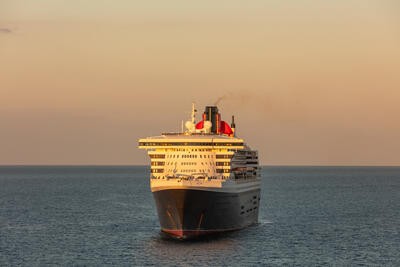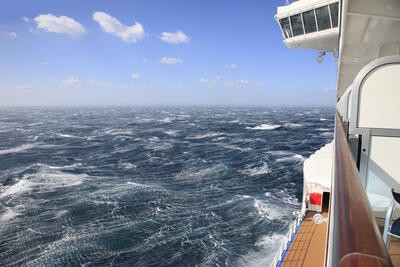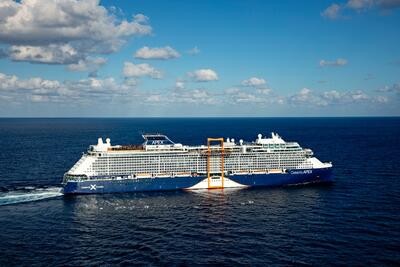Are you dreaming of a luxurious sea voyage? Wondering how quickly you can cross the ocean on an ocean liner? At SIXT.VN, we help you plan your perfect trip, ensuring you have all the information you need. Ocean liners travel at impressive speeds, connecting continents with style and efficiency. Explore Vietnam with ease, knowing your travel details are in expert hands. Let’s dive into the world of cruise ship speeds, oceanic voyages, and travel distances, ensuring your next adventure is both swift and memorable.
1. Understanding Ocean Liner Speed: Knots and Nautical Miles
When discussing how fast an ocean liner travels, it’s essential to understand the terminology. The speed of ships is measured in knots, where one knot equals one nautical mile per hour. A nautical mile is approximately 1.15 land miles (1.85 kilometers). So, when we talk about the speed of an ocean liner, we’re referring to how many nautical miles it covers in an hour. According to the National Ocean Service, a nautical mile is based on the Earth’s circumference and is used for navigation because of its relationship to degrees of latitude and longitude.
- Knots: Unit of speed (1 knot = 1 nautical mile per hour)
- Nautical Mile: Unit of distance (approximately 1.15 land miles)
2. Average Speed of Modern Ocean Liners
Modern ocean liners typically cruise at speeds between 18 to 22 knots, which translates to roughly 20 to 25 land miles per hour (32 to 40 kilometers per hour). However, some ocean liners are built for speed and can achieve higher velocities. For instance, Cunard’s Queen Mary 2, often considered the fastest ocean liner today, has a maximum speed of around 30 knots (34.5 mph or 55.5 km/h).
 Queen Mary 2 sailing
Queen Mary 2 sailing
This impressive speed allows it to complete transatlantic voyages between New York and Southampton in about seven nights. Consider using SIXT.VN for reliable airport transfer services in Hanoi to start your journey stress-free.
3. Factors Influencing Ocean Liner Speed
Several factors can influence how fast an ocean liner travels:
3.1. Ship Design
The design of the ship plays a crucial role in its speed capabilities. Ocean liners like the Queen Mary 2 are designed with a streamlined hull and powerful engines to maintain high speeds across the Atlantic. In contrast, cruise ships prioritize onboard amenities and stability, which may affect their maximum speed.
3.2. Weather Conditions
Weather conditions significantly impact the speed of an ocean liner. Rough seas, strong winds, and storms can force captains to reduce speed for safety. According to the National Weather Service, severe weather can reduce vessel speed by as much as 20-30% to ensure passenger and crew safety.
 Rough seas
Rough seas
3.3. Distance and Route
The distance and route of the voyage also affect the speed. Shorter routes, such as cruises to the Bahamas, may not require maximum speed, while longer transatlantic journeys demand higher speeds to maintain schedules.
3.4. Fuel Efficiency and Environmental Concerns
Modern ships are increasingly designed with fuel efficiency in mind, often using LNG-powered engines and other eco-friendly technologies. While these innovations reduce carbon emissions, they may not directly increase speed. Instead, they allow ships to maintain their current speeds while consuming less fuel, balancing environmental responsibility with operational efficiency.
3.5. Scheduled Arrival Time
Ocean liners often adjust their speed to adhere to scheduled arrival times at ports. Arriving too early can result in additional docking fees, so captains may reduce speed to optimize costs.
4. Ocean Liners vs. Cruise Ships: Speed Comparison
Ocean liners and cruise ships serve different purposes, which influences their design and speed capabilities. Ocean liners are designed for transportation, focusing on quickly and efficiently crossing large bodies of water. Cruise ships, on the other hand, prioritize the onboard experience and are designed as destinations in themselves.
| Feature | Ocean Liners | Cruise Ships |
|---|---|---|
| Primary Purpose | Transportation across oceans | Leisure and vacation |
| Speed | Higher average speeds (up to 30 knots) | Lower average speeds (18-22 knots) |
| Design Focus | Speed, stability, and transatlantic travel | Onboard amenities, entertainment, and relaxation |
| Example | Queen Mary 2 | Harmony of the Seas |
Harmony of the Seas, one of the largest cruise ships, can reach speeds of up to 25 knots, but typically cruises at around 18-19 knots to enhance passenger comfort and fuel efficiency.
5. The Queen Mary 2: A Case Study
The Queen Mary 2 stands out as one of the fastest and most iconic ocean liners. Built for transatlantic voyages, it maintains a high average speed to complete its journeys in a timely manner. Its design includes a long, slender hull and powerful engines that allow it to cut through the water efficiently.
 Queen Mary 2
Queen Mary 2
Key features of the Queen Mary 2:
- Maximum Speed: Approximately 30 knots
- Typical Transatlantic Voyage: 7 nights
- Design Focus: Speed and stability for ocean crossings
6. How to Enhance Your Travel Experience with SIXT.VN
Planning a trip to Vietnam? SIXT.VN offers a range of services to make your journey smooth and enjoyable:
6.1. Airport Transfer Services
Arrive in Hanoi with ease by booking our reliable airport transfer services. Our professional drivers will ensure you reach your destination comfortably and on time.
6.2. Hotel Booking Assistance
Finding the perfect accommodation is crucial for a great trip. SIXT.VN provides hotel booking assistance, offering a variety of options to suit your preferences and budget.
6.3. Tour Packages
Explore Hanoi and its surroundings with our curated tour packages. Whether you’re interested in historical sites, cultural experiences, or scenic landscapes, we have a tour for you.
6.4. Flight Booking Services
Let SIXT.VN handle your flight bookings. We’ll find the best deals and convenient schedules to fit your travel plans.
6.5. Tailored Itineraries
Need a personalized travel plan? Our expert travel consultants will create a tailored itinerary based on your interests and time frame, ensuring you make the most of your visit to Vietnam.
7. Booking Services with SIXT.VN: A Step-by-Step Guide
Booking your travel services with SIXT.VN is easy and convenient. Here’s a step-by-step guide:
7.1. Visit the SIXT.VN Website
Go to our website at SIXT.VN.
7.2. Select Your Desired Service
Choose from our range of services, including airport transfers, hotel bookings, tour packages, and flight bookings.
7.3. Enter Your Details
Fill in the required information, such as travel dates, destinations, and preferences.
7.4. Review and Confirm
Double-check your details and confirm your booking.
7.5. Make Payment
Complete the payment process using our secure payment gateway.
7.6. Receive Confirmation
You’ll receive a confirmation email with all the details of your booking.
8. The Future of Ocean Liner Travel
The future of ocean liner travel is likely to see continued innovation in ship design, fuel efficiency, and passenger experience. As environmental concerns grow, expect more ships to adopt sustainable technologies. Additionally, the demand for unique and luxurious travel experiences may drive the development of new and improved ocean liners that combine speed with comfort and elegance.
9. Tips for a Smooth Ocean Voyage
Planning an ocean voyage? Here are some tips to ensure a smooth and enjoyable experience:
- Book in Advance: Secure your spot early to get the best deals and cabin choices.
- Pack Appropriately: Bring clothing suitable for various weather conditions, as temperatures can vary during the voyage.
- Motion Sickness Remedies: If you’re prone to motion sickness, pack remedies like ginger tablets or acupressure bands.
- Stay Informed: Keep up-to-date with weather forecasts and ship announcements.
- Explore Onboard Activities: Take advantage of the many activities and entertainment options available on the ship.
10. FAQ About Ocean Liner Travel Speed
10.1. How fast does the average ocean liner travel?
The average ocean liner travels at a speed of 18 to 22 knots (20 to 25 land miles per hour).
10.2. What is the fastest ocean liner in the world?
Cunard’s Queen Mary 2 is considered the fastest ocean liner, with a maximum speed of around 30 knots.
10.3. How are ocean liner speeds measured?
Ocean liner speeds are measured in knots, where one knot equals one nautical mile per hour.
10.4. What factors affect the speed of an ocean liner?
Factors include ship design, weather conditions, distance, route, and fuel efficiency.
10.5. Are ocean liners faster than cruise ships?
Generally, ocean liners are faster than cruise ships because they are designed for transportation rather than leisure.
10.6. How can I book travel services with SIXT.VN?
Visit SIXT.VN, select your desired service, enter your details, review and confirm, make payment, and receive confirmation.
10.7. What services does SIXT.VN offer for travelers to Vietnam?
SIXT.VN offers airport transfer services, hotel booking assistance, tour packages, flight booking services, and tailored itineraries.
10.8. Why should I book with SIXT.VN?
SIXT.VN provides reliable, convenient, and personalized travel services, ensuring a smooth and enjoyable experience in Vietnam.
10.9. How do I prepare for potential weather delays on an ocean voyage?
Monitor weather forecasts, pack accordingly, and book return flights with flexibility to accommodate potential delays.
10.10. What are some tips for avoiding motion sickness on an ocean liner?
Use motion sickness remedies, choose a cabin in a stable part of the ship, and stay hydrated.
Planning a memorable trip to Vietnam? SIXT.VN is here to help with all your travel needs, from airport transfers to customized tour packages. Our reliable services and expert assistance ensure a smooth and enjoyable experience. Contact us today to start planning your adventure Address: 260 Cau Giay, Hanoi, Vietnam. Hotline/Whatsapp: +84 986 244 358. Website: SIXT.VN.



